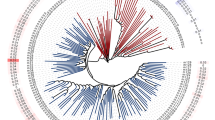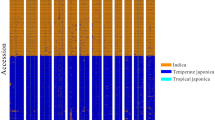Abstract
Introgression from soybean cultivars to its wild progenitor species is an interesting antidromic recombination in natural ecosystem with many consequences, including the alteration of genetic diversity, the origin of semi-wild soybean, and implication for biosafety of the wild progenitor species with future release of the genetically modified varieties. Although such interspecific introgression is not suspected to be ubiquitous in the sympatric regions of wild and cultivated soybeans, the documentations published based on some molecular experimental analyses on the introgression have been little substantiated by the occurring process morphologically and remain deficient for unquestionable evidence, owing to the lack of actual insight into the population dynamics. Here, we found the phenomenon of gene escape and presented the evidence for occurrence of introgression from soybeans into the wild species and for how originates about the semi-wild type soybean based on morphological investigation of population dynamics. Our results suggest that more attention should be paid to the escape of genetically modified genotypes to safeguard the biosafety of wild soybean gene pool, if GM soybeans are released in China, the place of origin of cultivated soybeans.

Similar content being viewed by others
References
Abe J, Hasegawa A, Fukushi H, Mikami T, Ohara M, Shimamoto Y (1999) Introgression between wild and cultivated soybean of Japan revealed by RFLP analysis for chloroplast DNA. Econ Bot 53:285–291
Ahrent DK, Caviness CE (1994) Natural cross pollination of twelve soybean cultivars in Arkansas. Crop Sci 34:376–378
Broich SL, Palmer RG (1980) A cluster analysis of wild and domesticated soybean phenotypes. Euphytica 29:23–32
Broich SL, Palmer RG (1981) Evolutionary studies of the soybean: the frequency and distribution of alleles among collections of Glycine max and G. soja of various origin. Euphytica 30:55–64
Caviness CE (1966) Estimates of natural cross pollination in Jackson soybeans in Arkansas. Crop Sci 6:211–212
Chen Y, Nelson L (2004) Genetic variation and relationship among cultivated, wild and semi-wild soybean. Crop Sci 44:316–325
Close PS, Shoemaker RC, Keim P (1989) Distribution of restriction site polymorphism within the chloroplast genome of the genus Glycine, subgenus Soja. Theor Appl Genet 77:768–776
Ellstrand NC, Prentice HC, Hancock JF (1999) Gene flow and introgression from cultivated plants into their wild relatives. Annu Rev Ecol Evol Syst 30:539–563
Fujita R, Ohara M, Okazaki O, Shimamoto Y (1997) The extent of natural cross-pollination in wild soybean (Glycine soja). J Hered 88:124–128
Fukuda Y (1933) Cytological studies on the wild and cultivated Manchurian soybeans. Jap J Bot 6:489–506
Gai JY, Xu DH, Gao Z, Shimamoto Y, Abe J, Fukushi H, Kitajima S (2000) Studies on the evolutionary relationship among eco-types of G. max and G. soja in China (in Chinese). Acta Agron Sin 26:513–520
Hermann FJ (1962) A revision of the genus Glycine and its immediate allies. USDA Tech Bull 1268:1–79
Hymowitz T (1970) On the domestication of the soybean. Econ Bot 24:408–421
Kiang YT, Chiang YC, Kaizuma N (1992) Genetic diversity in natural populations of wild soybean in Iwate Prefecture, Japan. J Hered 83:325–329
Kuroda Y, Kaga A, Tomooka N, Vaughan A (2006) Population genetic structure of Japanese wild soybean (Glycine soja) based on microsatellite variation. Mol Ecol 15:959–974
Lee JD, Yoon YH, Chung IK, Park SK, Hwang YH (2005) A new Glycine soja germplasm accession with green seed-coat color. (Japan) Breed Sci 55:21–25
Li FS (1994) Study on origin and Evolution of soybean (in Chinese). Soybean Sci 13:61–66
Lu SL (1978) Discussion on the original region of cultivated soybean in China (in Chinese). Sci Agri Sin No. 6:90–94
Shoemaker RC, Hatpopulation PM, Palmer RG, Atherly AG (1986) Chloroplast DNA variation in the genus Glycine subgenus Soja. Hered 77:26–30
Sisson HD, Brim CA, Levings CS (1978) III. Characterization of cytoplasmic diversity in soybeans by restriction endonuclease analysis. Crop Sci 18:991–996
Skvortzow BW (1927) The soybean-wild and cultivated in Eastern Asia. Proc Manchurian Res Soc Publ Ser A Natural Hist Sec No. 22:1–8
Vavilov N (1951) The origin, variation, immunity and breeding of cultivated plants. (Trans. by Chester KS) Chronica Botanica Vol. 13. The Ronald Press Complany, New York
Wang JL (1947) Evolution of soybean traits (in Chinese). Agri J 12:6–11
Wang LZ (2007) The origin, evolution and dissemination. In: Wang LZ, Guo QY (eds) Current Chinese soybean (in Chinese). The Jindun Press, Beijing, pp 27–44
Wang KJ, Li FS, Cheema AA (2001) Studies on the Distribution of Wild Soybean (Glycine soja) in China. Pakistan J Biol Sci 4:149–155
Wang KJ, Li XH, Li FS (2008) Phenotypic diversity of the big seed type subcollection of wild soybean (Glycine soja Sieb. et Zucc.) in China. Genet Resour Crop Evol 55:1335–1346
Xu B, Zheng HY, Lu QH, Zhao SW, Zhou SH, Hu ZA (1986) Three new evidences of the original area of soybean (in Chinese). Soybean Sci 5:123–130
Zhao TJ, Gai JY (2004) The origin and evolution of cultivated soybean [Glycine max (L.) Merr.] (in Chinese). Sci Agri Sin 37:954–962
Acknowledgments
This work was supported by the “Natural Science Foundation of Chongqing” (Item No: CSTC, 2009BA1033) and by the “Environmental and Biosafety Assessment of Transgenetic Maize, Soybean and Wheat”, the Chinese Ministry of Agriculture (Item No. 2008ZX08011-003).
Author information
Authors and Affiliations
Corresponding author
Rights and permissions
About this article
Cite this article
Wang, KJ., Li, XH., Zhang, JJ. et al. Natural introgression from cultivated soybean (Glycine max) into wild soybean (Glycine soja) with the implications for origin of populations of semi-wild type and for biosafety of wild species in China. Genet Resour Crop Evol 57, 747–761 (2010). https://doi.org/10.1007/s10722-009-9513-4
Received:
Accepted:
Published:
Issue Date:
DOI: https://doi.org/10.1007/s10722-009-9513-4




